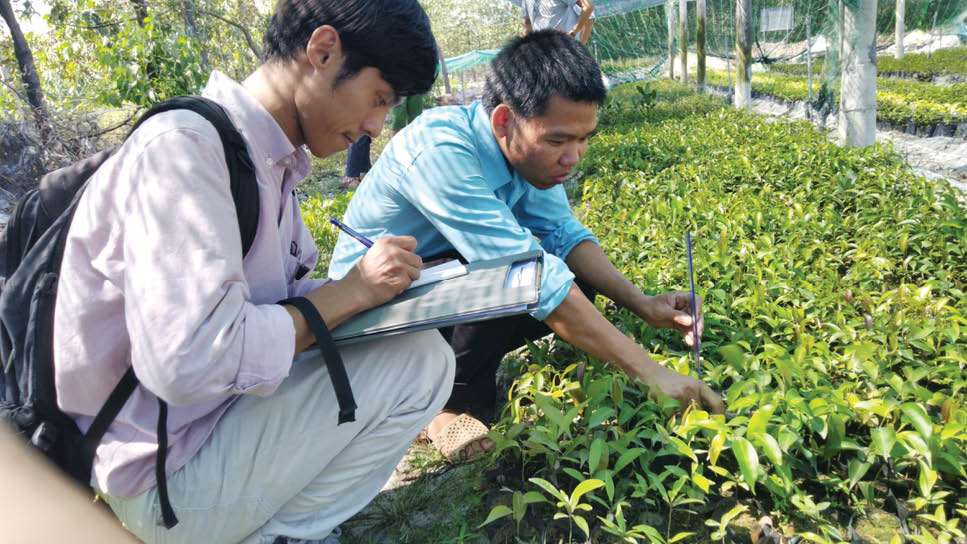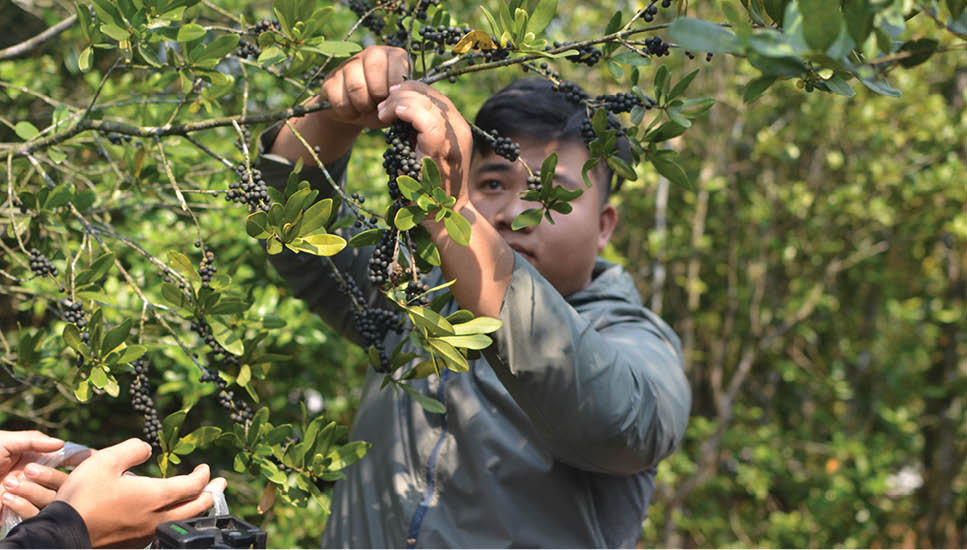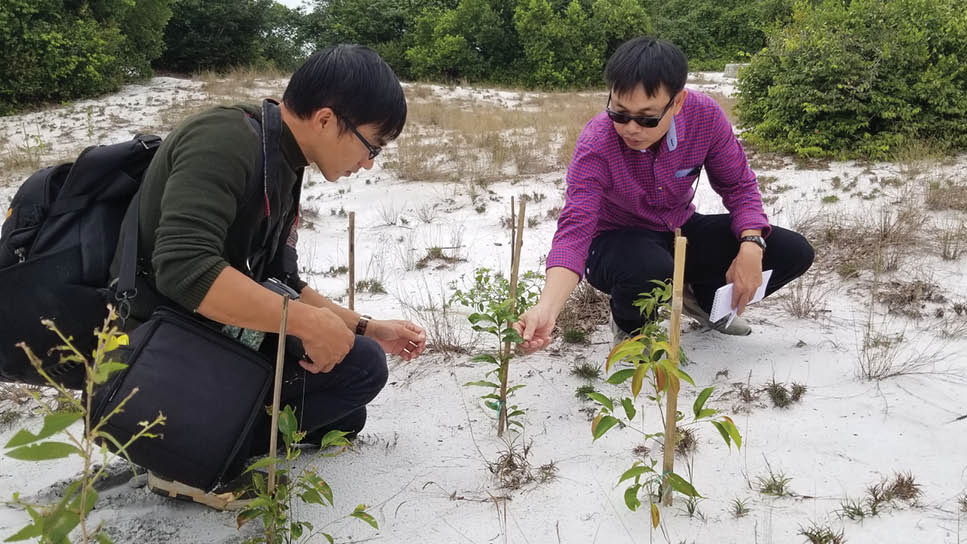
Keeping track of cultivating seedlings process
Welcoming new breezes
Under the rare sunshine of the first day of December, there is a bustling scene of people passing budding native plant seedlings on the white sandy beaches at Dien Huong and Phong Chuong communes (Phong Dien district located about 30km north of Hue city), and starting their work of greening the white sand that they have wanted to do earlier.
In the memory of those living in the sandy area of Hoa-Binh-Chuong (3 communes of Phong Hoa, Phong Binh, and Phong Chuong) and the coastal sandy area of Ngu Dien (Phong Dien district), species of trees, flowers and fruits of this region have been intimately attached to local people. Due to the site conditions and human impacts, Phong Dien sand dunes, except for places where there are industrial zone and shrimp raising ponds, have become bigger and bigger white sand areas in the past few decades. The effect of their shielding and protecting houses, gardens and villages of natural forests is also weakened.

Collecting seeds from the mother plant for seedling
Having a strong attachment to the white sandy countryside of Dien Huong commune for more than 70 years, Mr. Tran Danh does not forget the difficulties that local people had to suffer from losing dunes forest. Mr. Danh shares that in local people’s thoughts, “if dune forests are ruined, the village will be withered”. Therefore, people try to keep them for many years. But due to the site conditions, weather and lack of scientific knowledge, it is still difficult to green the high percentage of deserted sand.
In 2018, the coastal sandy area of the Central region was awakened again. Initiators and leaders of this initiative are lovers of trees and nature from the Institute of Resources and Environment – Hue University (IREN). Over a year, together with their colleagues and sponsors at the Germany’s International Climate Initiative (IKI), local authorities and communities of sandy areas, they have conducted field surveys and research to implement the project of restoring dunes and mangrove forests (hereafter called CFR project).
Dr. Ho Dac Thai Hoang - Director of the Institute of Resources and Environment, says that sandy areas are still “blank” in research documents of forestry sector so far. After the researching process, the CFR project team chooses to “lean” on the ecosystem and follow natural rules to revive native forests along the coastal sand dunes of three provinces in the North Central Coast, including Quang Binh, Quang Tri and Thua Thien Hue.
Preventing “flying and jumping sand”
This project is considered the first one to nurse native plants in sandy areas of Vietnam. In order to have seedlings, project members have to pick up and collect seeds at natural sand dunes of Phong Dien and Quang Dien districts, and Hai Duong commune (Quang Tri province). Due to few studies on native plants, the team meets with difficulties during the seed collection process in determining the accurate time for plants’ blossom and fruiting cycles.
Through many challenges, 4 target nurseries in cooperation with the IREN have successfully cultivated 580,000 seedlings of 12 indigenous tree species, including camellia sasanqua, Lithocarpus concentricus, Casearia grewiaefolia, Litsea glutinosa, Melaleuca cajuputi, Shorea falcata, Sindora tonkinensis, Syzygium chanlos, Vatica mangachapoi..., which are compatible to rehabilitate 450 hectares of coastal sandy area in 3 provinces of North Central Vietnam.

Field inspection of the growth and development of newly-planted native trees
The natural forest structure in sandy areas usually grows in clusters of 9-15 tree species. Hence, the planting plan of the project is modeled on this distribution. The vegetation clusters create favorable micro-habitats in terms of the ability to retain moisture and accumulate organic matter, and help to limit the adverse effects from “flying and jumping sand” (sand drift) caused by the wind.
Establishing ecological and livelihood zones
According to the research, O Lau wetland – a part of Tam Giang-Cau Hai lagoon system located on the North of Thua Thien Hue is connected with the land of Hai Lang district (Quang Tri) to form a wetland zone of high biodiversity.
The objective of the CFR project is to restore and replant native (dune) forests in Dien Huong commune to reconnect the vegetation to the south part of Quang Tri province and dead pond areas, and to expand the lagoon and dam areas. At the same time, it will plant about 100ha of native trees in Phong Chuong commune to create the Dien Huong-Phong Chuong forest range for migratory bird sanctuary and natural flora and fauna resources.
Mr. Ho Ngoc Anh Tuan – an IREN researcher and a member of CFR project, explains that compared to the “normal” inland plants, dense native trees on sand dunes have protected local residents from extreme weather impacts and helped them develop their livelihoods from early days. Restoring ecosystems will retain and increase freshwater resources in the back of the sand dunes, and promote commercial fish raising activities for local people...
(1).jpg)
There are still a lot of empty spaces in the sandy dune area of Phong Dien
As for Dr. Ho Dac Thai Hoang, it needs 10 years or even more to see changes and results of plantation, especially the restoration of native forests. However, he believes that the plan of planting with 3 different groups of trees will achieve the goal of restoring ecological values, protecting sand dunes and estuaries, and creating livelihoods for communities with an aim at adapting to climate change. The three groups of trees include a group of those which are endemic trees or listed in the red book, a group of trees for livelihood, and a group of trees for ecological restoration.
These groups of trees will open up opportunities for developing the eco-tourism for coastal sandy areas, creating a stable raw material area for medicine (such as Melaleuca cajuputi) and cooking oil (extraction of the camellia sasanqua fruits) with a great commercial value.
The project “Ecosystem-based Adaptation in the North Central Coast of Vietnam: Restoration and Co-management of Degraded Dunes and Mangroves (CFR project) includes planting 450 hectares of native trees and 50 hectares of mangroves in 2019 and 2020 at coastal sandy areas and inland areas of 3 provinces of Quang Binh, Quang Tri and Thua Thien Hue. As for Thua Thien Hue, it will plant about 250ha of forest in 2 communes of Dien Huong and Phong Chuong. The success of the project will serve as the basis for the restoration of similar white sand dunes along the Central Coast.
Story: Hoai Thuong
Photos: H.Thuong – A.Tuan